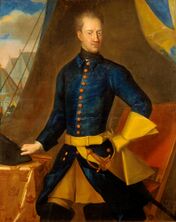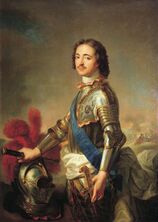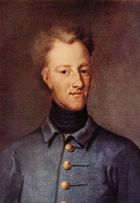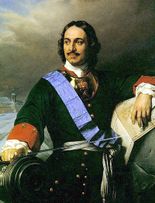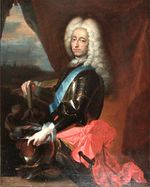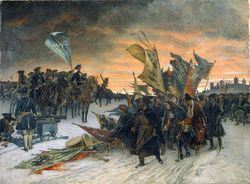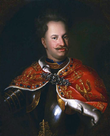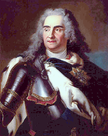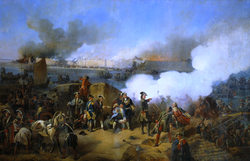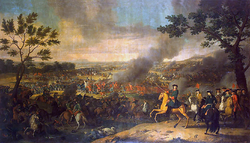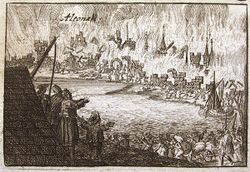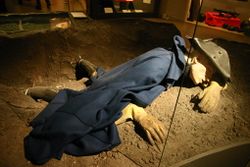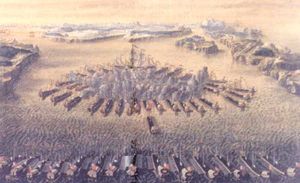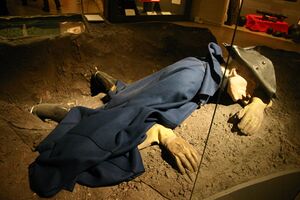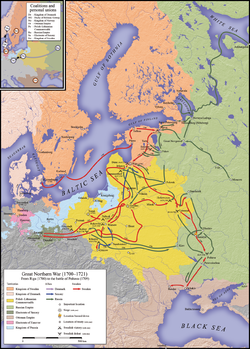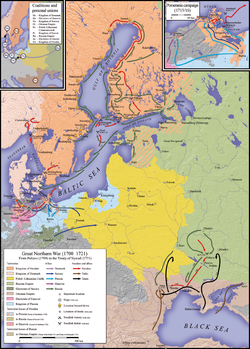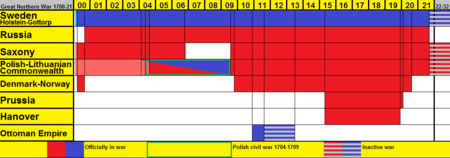الحرب الشمالية العظمى
| الحرب الشمالية العظمى Great Northern War | |||||||||
|---|---|---|---|---|---|---|---|---|---|
| جزء من الحروب الروسية السويدية، الحروب الپولندية السويدية والحروب الدنماركية السويدية | |||||||||
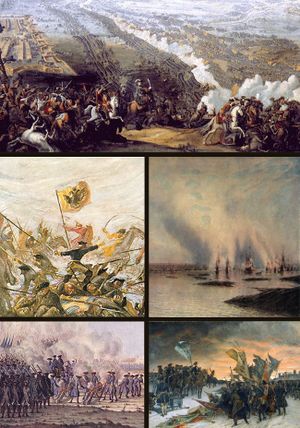 الحرب الشمالية العظمى. مع عقارب الساعة من أعلى: معركة پولتاڤا، معركة گانگوت، معركة نارڤا، Battle of Gadebusch، معركة ستوركيرو | |||||||||
| |||||||||
| المتحاربون | |||||||||
|
|
(1700, 1709–) (1700–06, 1709–) (1700–04؛ 1709–) | ||||||||
| القادة والزعماء | |||||||||
|
|
(اتحاد شخصي) (اتحاد شخصي) | ||||||||
| القوى | |||||||||
|
77,000–393,400 77,000–135,000 Total Swedish troops across the whole country including garrisons and militia (1700 and 1707, respectively) 100,000–200,000 Ottomans (only participated in one battle, remained passive during the rest of the war) 8,000–40,000 Cossacks 16,000 Polish troops (1708) |
على الأقل 360,000 170,000 روسي (facing the Swedes, garrisons not included) +40,000 Danes/Norwegians +100,000 پولنديون وساكسون (at the most) حوالي 50,000 (42 أفواج) Prussians unknown amount from Hannover[1][2][بحاجة لمصدر] | ||||||||
| الضحايا والخسائر | |||||||||
| حوالي 25,000 سويدي قُتل في القتال، يقدر إجمالي عددهم 175,000 قتلتهم المجاعة والأمراض والإرهاق.[3] |
غير معروفة. على الأقل 75,000 روسي، 14,000–20,000 پولندي وساكسوني 8,000 دنماركي قتل في المعارك الأكبر، 60,000 دنماركي الإجمالي بين 1709 و1719.[4] | ||||||||
| جزء من سلسلة عن |
| اسكندناڤيا |
|---|
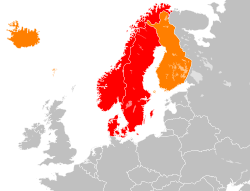 |
الحرب الشمالية العظمى Great Northern War (من 1700–1721) كانت نزاعاً نجح فيه تحالف بقيادة قيصرية روسيا من انتزاع التفوق من الامبراطورية السويدية في اوروبا الوسطى الشمالية واوروبا الشرقية. وكان القادة الأوائل للتحالف المضاد للسويد هم پطرس الأكبر من روسيا، فردريك الرابع من الدنمارك-النرويج وأوگوست الثاني القوي من ساكسه-پولندا-لتوانيا. وقد أُجبر فردريك الرابع وأوگوست الثاني على ترك التحالف في 1700 و 1706 بالترتيب، ولكن عادا فانضما إليه في 1709. وانضم جورج الأول من برونزويك-لونبورگ (هانوڤر) إلى التحالف في 1714 عن هانوڤر وفي 1717 عن بريطانيا، وانضم فردريك وليام الأول من براندنبورگ-پروسيا في 1715.
قاد كارل الثاني عشر الجيش السويدي. وفي الجانب السويدي كان هناك هولشتاين-گوتورپ، وعدة قادة بولنديين ولتوانيين تحت إمرة ستانسواف Leszczyński (1704–10) والقوزاق تحت قيادة الهتمان الاوكراني إيڤان مازپا (1708–10). وقد استضافت الدولة العثمانية مؤقتاً كارل الثاني عشر من السويد وتدخلت ضد بطرس الأول.
The war began when an alliance of Denmark–Norway, Saxony and Russia, sensing an opportunity as Sweden was ruled by the young Charles XII, declared war on the Swedish Empire and launched a threefold attack on Swedish Holstein-Gottorp, Swedish Livonia, and Swedish Ingria. Sweden parried the Danish and Russian attacks at Travendal (August 1700) and Narva (November 1700) respectively, and in a counter-offensive pushed Augustus II's forces through the Polish–Lithuanian Commonwealth to Saxony, dethroning Augustus on the way (September 1706) and forcing him to acknowledge defeat in the Treaty of Altranstädt (October 1706). The treaty also secured the extradition and execution of Johann Reinhold Patkul, architect of the alliance seven years earlier. Meanwhile, the forces of Peter I had recovered from defeat at Narva and gained ground in Sweden's Baltic provinces, where they cemented Russian access to the Baltic Sea by founding Saint Petersburg in 1703. Charles XII moved from Saxony into Russia to confront Peter, but the campaign ended in 1709 with the destruction of the main Swedish army at the decisive Battle of Poltava (in present-day Ukraine) and Charles' exile in the Ottoman town of Bender. The Ottoman Empire defeated the Russian-Moldavian army in the Pruth River Campaign, but that peace treaty was in the end without great consequence to Russia's position.
After Poltava, the anti-Swedish coalition revived and subsequently Hanover and Prussia joined it. The remaining Swedish forces in plague-stricken areas south and east of the Baltic Sea were evicted, with the last city, Riga, falling in 1710. The coalition members partitioned most of the Swedish dominions among themselves, destroying the Swedish dominium maris baltici. Sweden proper was invaded from the west by Denmark–Norway and from the east by Russia, which had occupied Finland by 1714. Sweden defeated the Danish invaders at the Battle of Helsingborg. Charles XII opened up a Norwegian front but was killed in the Siege of Fredriksten in 1718.
The war ended with the defeat of Sweden, leaving Russia as the new dominant power in the Baltic region and as a new major force in European politics. The Western powers, Great Britain and France, became caught up in the separate War of the Spanish Succession (1701–1714), which broke out over the Bourbon Philip of Anjou's succession to the Spanish throne and a possible joining of France and Spain. The formal conclusion of the Great Northern War came with the Swedish-Hanoverian and Swedish-Prussian Treaties of Stockholm (1719), the Dano-Swedish Treaty of Frederiksborg (1720), and the Russo-Swedish Treaty of Nystad (1721). By these treaties Sweden ceded its exemption from the Sound Dues[5] and lost the Baltic provinces and the southern part of Swedish Pomerania. The peace treaties also ended its alliance with Holstein-Gottorp. Hanover gained Bremen-Verden, Brandenburg-Prussia incorporated the Oder estuary (Stettin Lagoons), Russia secured the Baltic Provinces, and Denmark strengthened its position in Schleswig-Holstein. In Sweden, the absolute monarchy had come to an end with the death of Charles XII, and Sweden's Age of Liberty began.[5]
. . . . . . . . . . . . . . . . . . . . . . . . . . . . . . . . . . . . . . . . . . . . . . . . . . . . . . . . . . . . . . . . . . . . . . . . . . . . . . . . . . . . . . . . . . . . . . . . . . . . . . . . . . . . . . . . . . . . . . . . . . . . . . . . . . . . . . . . . . . . . . . . . . . . . . . . . . . . . . . . . . . . . . . .
خلفية
Between 1560 and 1658, Sweden created a Baltic empire centred on the Gulf of Finland and comprising the provinces of Karelia, Ingria, Estonia, and Livonia. During the Thirty Years' War Sweden gained tracts in Germany as well, including Western Pomerania, Wismar, the Duchy of Bremen, and Verden. During the same period, Sweden conquered Danish and Norwegian provinces north of the Sound (1645; 1658). These victories may be ascribed to a well-trained army, which despite its comparatively small size, was far more professional than most continental armies, and also to a modernization of administration (both civilian and military) in the course of the 17th century, which enabled the monarchy to harness the resources of the country and its empire effectively. Fighting in the field, the Swedish army (which during the Thirty Years' War contained more German and Scottish mercenaries than ethnic Swedes, but was administered by the Swedish Crown[6]) was able, in particular, to make quick, sustained marches across large tracts of land and to maintain a high rate of small arms fire due to proficient military drill.
However, the Swedish state ultimately proved unable to support and maintain its army in a prolonged war. Campaigns on the continent had been proposed on the basis that the army would be financially self-supporting through plunder and taxation of newly gained land, a concept shared by most major powers of the period. The cost of the warfare proved to be much higher than the occupied countries could fund, and Sweden's coffers and resources in manpower were eventually drained in the course of long conflicts.
The foreign interventions in Russia during the Time of Troubles resulted in Swedish gains in the Treaty of Stolbovo (1617). The treaty deprived Russia of direct access to the Baltic Sea. Russian fortunes began to reverse in the final years of the 17th century, notably with the rise to power of Peter the Great, who looked to address the earlier losses and re-establish a Baltic presence. In the late 1690s, the adventurer Johann Patkul managed to ally Russia with Denmark and Saxony by the secret Treaty of Preobrazhenskoye, and in 1700 the three powers attacked.
الخصوم
المعسكر السويدي
كارل الثاني عشر من السويد[nb 1] succeeded Charles XI of Sweden in 1697, aged 14. From his predecessor, he took over the Swedish Empire as an absolute monarch. Charles XI had tried to keep the empire out of wars, and concentrated on inner reforms such as reduction and allotment, which had strengthened the monarch's status and the empire's military abilities. Charles XII refrained from all kinds of luxury and alcohol and usage of the French language, since he considered these things decadent and superfluous. He preferred the life of an ordinary soldier on horseback, not that of contemporary baroque courts. He determinedly pursued his goal of dethroning his adversaries, whom he considered unworthy of their thrones due to broken promises, thereby refusing to take several chances to make peace. During the war, the most important Swedish commanders besides Charles XII were his close friend Carl Gustav Rehnskiöld, also Magnus Stenbock and Adam Ludwig Lewenhaupt.
Charles Frederick, son of Frederick IV, Duke of Holstein-Gottorp (a cousin of Charles XII)[nb 1] and Hedvig Sophia, daughter of Charles XI of Sweden, had been the Swedish heir since 1702. He claimed the throne upon Charles XII's death in 1718, but was supplanted by Ulrike Eleonora. Charles Frederick was married to a daughter of Peter I, Anna Petrovna.
Ivan Mazepa was a Ukrainian Cossack hetman who fought for Russia but defected to Charles XII in 1708. Mazepa died in 1709 in Ottoman exile.
معسكر الحلفاء
Peter the Great became Tsar in 1682 upon the death of his elder brother Feodor but did not become the actual ruler until 1689. He commenced reforming the country, turning the Russian tsardom into a modernized empire relying on trade and on a strong, professional army and navy. He greatly expanded the size of Russia during his reign while providing access to the Baltic, Black, and Caspian seas. Beside Peter, the principal Russian commanders were Aleksandr Danilovich Menshikov and Boris Sheremetev.
Augustus II the Strong, elector of Saxony and another cousin of Charles XII,[nb 1] gained the Polish crown after the death of King John III Sobieski in 1696. His ambitions to transform the Polish–Lithuanian Commonwealth into an absolute monarchy were not realized due to the zealous nature of the Polish nobility and the previously initiated laws that decreased the power of the monarch. His meeting with Peter the Great in Rawa Ruska in September 1698, where the plans to attack Sweden were made, became legendary for its decadence.
Frederick IV of Denmark-Norway, another cousin of Charles XII,[nb 1] succeeded Christian V in 1699 and continued his anti-Swedish policies. After the setbacks of 1700, he focused on transforming his state, an absolute monarchy, in a manner similar to Charles XI of Sweden. He did not achieve his main goal: to regain the former eastern Danish provinces lost to Sweden in the course of the 17th century. He was not able to keep northern Swedish Pomerania, Danish from 1712 to 1715. He did put an end to the Swedish threat south of Denmark. He ended Sweden's exemption from the Sound Dues (transit taxes/tariffs on cargo moved between the North Sea and the Baltic Sea).
Frederick William I entered the war as elector of Brandenburg and king in Prussia – the royal title had been secured in 1701. He was determined to gain the Oder estuary with its access to the Baltic Sea for the Brandenburgian core areas, which had been a state goal for centuries.
George I of the House of Hanover, elector of Hanover and, since 1714, king of Great Britain and of Ireland, took the opportunity to connect his landlocked German electorate to the North Sea.
حجم الجيوش
1700: الدنمارك، ريگا ونارڤا
نمى إلى استوكهولم نبأ غامض عن اتفاق الحلف. فالتأم المجلس الملكي ليناقش إجراءات الدفاع. وكان الرأي الغالب وجوب فتح باب المفاوضات مع أحد الحلفاء لعقد صلح منفرد معه. واستمع شارل ملياً وهو صامت، ثم انتفض قائماً وقال: "أيها السادة، لقد عقدت النية على ألا أخوض حرباً ظالمة ما حييت ولكني... لن أنهي حرباً عادلة إلا بالقضاء المبرم على أعدائي(25)". ثم طلق كل لهو وترف واتصال بالنساء ومعاقرة للخمر. وكان جيشه وبحريته مستعدين، فغادر معهما استوكهولم في 24 أبريل 1700 ليبدأ واحدة من أروع السير الحربية في التاريخ. ولم يشهد عاصمة ملكه بعدها قط.
وبدأ بمهاجمة الدنمارك، فقد كان عليه أن يحمي ولايات السويد الجنوبية من هجمات الدنمارك وهو يواجه بولندة وروسيا. ثم قاد سفنه عبر مضيق الساوند-المفترض أنه لا يصلح للملاحة-بما عهد فيه من جرأة وسرعة، رغم اعتراض أميرال بحريته، ورسا على سييلاند، التي لا تبعد عن كوبنهاجن سوى أميال (4 أغسطس 1700). وسارع فردريك الرابع ملك الدنمرك غلى إبرام صلح ترافندال معه (18 أغسطس) خشية أن تسقط عاصمته، ودفع تعويضاً قدره 200.000 ريال دنمركي، وأقسم أنه لن يهاجم السويد أبداً.
وفي مايو 1700 حاول أغسطس الثاني الاستيلاء على ريجا. ولكن هزمه الكونت إريك دالبرگ، القائد السويدي البالغ من العمر خمسة وسبعين عاماً، والذي اكتسب لقب "فوبان السويد" لمهارته في فن التحصين. وتقهقر أوغسطس وناشد بطرس أن يخفف عنه بغزوه اينجريا. واستجاب بطرس بأن أمر أربعين ألف مقاتل بحصار نارفا. وأراد شارل الثاني عشر أن يساعد دالبيرج، فنقل جيشه بالبحر إلى برناو (بارنو)، على خليج ريجا، ولكنه حين وجد ذلك المقاتل منتصراً، اتجه شمالاً. واخترق المناقع والممرات الخطرة ثم ظهر فجأة في مؤخرة جيش بطرس. وأخذ القيصر على غرة، فبدا منه ما بدا جبناً معيباً، إذ ترك الجيش (الذي كان يخدم فيه ملازماً فقط)، وفرّ إلى نوڤگورود وموسكو. وأغلب الظن أنه عرف عن مجنديه الغشم سينهارون في أول امتحان لهم، ولم يكن في وسعه أن يترك العدو يأسره، لأنه رأى نفسه أعظم قيمة لروسيا حياً منه ميتاً. أما الجيش الروسي، الذي بلغ أربعين ألفاً، والذي كان يقوده الأمير المجري كارل يوجين ديكروا قيادة عاجزة، فقد هزمه جنود شارل الثمانية الآلاف في معركة نارڤا (20 نوفمبر 1700)، وكانت أول نكسة في حياة بطرس بعد صباه.
وألح القواد السويديون على كارل في أن يزحف على موسكو ويجهز على بطرس. ولكن جيش شارل كان صغيراً، والشتاء حل، وكل شجاعة، حتى شجاعة هذا النابليون الشاب، لا بد أن تتردد أمام مسافات روسيا المترامية فضلاً عن مشكلة إطعام الجيش في أرض معادية. ثم (ما دامت العهود والمواثيق حبراً على ورق) هل يستطيع أن يركن إلى ملك الدنمرك، أو ملك بولندة، في ألا يغزو أحدهما السويد وجيشها الرئيسي وقائدها نائيان عن أرض الوطن؟ وبعد أن أعاد شارل تنظيم حكومة ليفونيا ودفاعها، سار جنوباً إلى بولندة، واحتل وارسو دون عناء (1720) على نحو ما فعل جده قبل سبعة وأربعين عاماً، وخلع أوغسطس، ونصب ستانيسلاس لزكزنسكي ملكاً على بولندة (1704). لقد هزم الآن كل حليف من الحلفاء، ولكن الدب الروسي لم يكد يبدأ النزال.
ذلك أن بطرس لم يفق من رعبه فحسب، بل نظم جيشاً آخر وجهزه. ولكي يزوده بالمدافع أمر بأن تصهر أجراس الكنائس والأديار، وصنع ثلاثمائة مدفع، وأنشئت مدرسة لتدريب رجال المدفعية. وسرعان ما أخذت القوات المجندة الجديدة في إحراز الانتصارات، وتقدمت كتيبة مدفعية بطرس غيرها في الاستيلاء على نينسكانس، عند مصب نيفا (1703)، وهناك شرع القيصر لتوه في بناء "بطرسبرج" دون أن يدرك إلى ذلك الحين أنها ستكون عاصمة ملكه، ولكنه صمم على أن تكون أحد منافذه إلى البحر. وبينما كان شارل مشغولاً في بولندة، ظهر بطرس ثانية أمام نارفا، وكان شارل قد ترك فيها حامية ضئيلة، واقتحم الروس القلعة الكبيرة (20 أغسطس 1704)، وثأر المنتصرون لأنفسهم من فشلهم السابق بمذبحة رهيبة، وضع لها بطرس حداً في النهاية بأن قتل بيديه اثني عشر من الروس المتعطشين للدماء.
1701–1706: پولندا-لتوانيا/ساكسونيا
وفي بولندة بدا أن انتصار كارل كامل. فقد وقع أوغسطس المخلوع معاهدة اعترف فيها بلزكزنسكي ملكاً، وتخلى عن أحلافه ضد السويد، وأسلم لكارل الرجل الذي نظم الحلف أولاً، فحطم جسد يوهان فون باتكول على دولاب التعذيب ثم قطع رأسه (1707). ووجد بطرس نفسه وحيداً أمام هذا الإرهاب السويدي الشاب. فحاول أن يرشو الوزارة الإنجليزية لترتب له صلحاً، ولكنها رفضت أن تتدخل. ومضي عامل بر رأساً إلى ملبره، فوافق على الوساطة لقاء إمبرة في روسيا(26)، وعرض عليه بطرس كييف أو فلاديمير أو سيبيريا، وضماناً من خمسين ألف تالر في العام، و "ياقوتة ماسية لا يملك نظيرها أي ملك أوربي"(27)، ولكن هذه المفاوضات أخفقت. وتعاطف الساسة الغربيون مع كارل، واحتقروا أوغسطس، وخافوا من بطرس، وكانت حجة بعضهم أنه لو سمح لروسيا بالتوسع غرباً، فإن أوربا كلها سترتعد بعد قليل أمام فيضان سلافي(28).
. . . . . . . . . . . . . . . . . . . . . . . . . . . . . . . . . . . . . . . . . . . . . . . . . . . . . . . . . . . . . . . . . . . . . . . . . . . . . . . . . . . . . . . . . . . . . . . . . . . . . . . . . . . . . . . . . . . . . . . . . . . . . . . . . . . . . . . . . . . . . . . . . . . . . . . . . . . . . . . . . . . . . . . .
1702–1710: روسيا ومقاطعات البلطيق
وفي أول يناير 1708 عبر شارل الفستولا فوق جليد غير مأمون على رأس 44.000 مقاتل نصفهم من الفرسان. فوصل إلى جرودنو في اليوم السادس والعشرين بعد أن رحل عنها بطرس بساعتين فقط. ذلك أن رأي القيصر استقر على الدفاع بالعمق والتخريب. فأمر جيوشه بأن تتقهقر، وتستدرج شارل ليوغل داخل الفرشة الروسية أبعد فأبعد، وتحرق كل المحاصيل أثناء مسيرتها، وأمر الفلاحين بأن يخفوا قمحهم داخل الأرض أو تحت الثلوج، ويشتتوا ماشيتهم في الغابات والمستنقعات. وعهد إلى الزعيم القوزاقي إيڤان مازيپا بمهمة الدفاع عن "روسيا الصغيرة" وأوكرانيا. وكان مازيبا قد نشيء وصيفاً في البلاط البولندي. وبأمر من نبيل بولندي أغوى ايفان زوجته رباط عرياناً على حصان أوكراني وحشي، وأرهب الحصان عمداً بضربات سوط وإطلاق مسدس عند أذنه (كما سيري بايرون)، واندفع الحصان خلال الإخراج والغابات إلى مسارحه الأولى، ولكن مازيبا ظل على قيد الحياة وإن تمزق لحمه وسال دمه، وارتقى حين أصبح زعيماً لقوزاق زابوروج. وتظاهر بالولاء لبطرس، ولكنه كره أوتقراطية القيصر، وترقب الفرصة للثورة. فلما سمع بأن بطرس يتقهقر وكارل يتقدم، قرر أن فرصته قد حانت. فأرسل إلى كارل يعرض عليه التعاون معه.
ولعل هذا العرض هو الذي حدا بشارل إلى المضي في زحفه المتهور داخل روسيا. وبدأت سياسة "الأرض المحرقة" تؤتي ثمارها، فلم يجد السويديون غير برية متفحمة في طريقهم وأخذوا يتضورون جوعاً. وكان شارل قد اعتمد على تعزيزات انتظر وصولها من ريجا، وقد حاولت أن تصله ولكن الروس دمروها نصف تدمير في طريقها. وعلل شارل نفسه بأن مازيبا سينضم إليه بالإمداد وقوة قوزاق الدنيبر كاملة، ولكن بطرس، الذي توجس من خيانة مازيبا، جرد جيشاً بقيادة الكسندر دانيلوفتش منشيكوف ليقبض عليه، وفوجئ الزعيم قبل أن يستطيع إيقاظ فرسانه، ففر غلى شارل عند هوركي جالباً معه ألفاً وثلاثمائة رجل فقط. وزحف شارل جنوباً ليستولي على عاصمة مازيبا، واسمها باتورين، ويأخذ مؤنها، ولكن منشيكوف سبقه إليها، وأحرق المدينة وسواها بالتراب، وعين زعيماً موالياً لروسيا. واستعمل بطرس كل سلاح، فثنى القوزاق عن الانضمام إلى السويديين بمنشورات وصفت الغزاة بأنهم مهرطقون "ينكرون عقائد الدين الصحيح ويبصقون على صورة العذراء المقدسة"(29). ولم يبق شارل من الأمل إلا في أن يخف التتار والترك لنجدته انتقاماً لاستيلاء بطرس على آزوف.
ولكن أحداً لم يأت، وكان شتاء 1708-9 عدواً رهيباً للسويديين. كان شتاء قارساً جداً في كل أرجاء أوربا، فتجمد البلطيق غلى عمق سمح لعربات النقل الثقيلة أن تعبر الساوند على الجليد، وفي ألمانيا ماتت أشجار الفاكهة، وغطى الجليد الرون في فرنسا، والقنوات في البندقية. وفي أوكرانيا كست الثلوج الأرض، من أول أكتوبر إلى 5 أبريل، وسقطت الطيور نافقة أثناء طيرانها، وتجمد اللعاب في طريقه من الفم إلى الأرض، وتجمد النبيذ المسكرات فأصبحت كتلاً صلبة، واستحال إشعال الحطب في العراء، وكانت الريح ماضية كالمدى في هبوبها على السهول المنبسطة وعلى وجوه الناس. واحتمل جنود شارل في تجلد صامت بينما لقى ألفان منهم حتفهم جوعاً أو برداً. قال شاهد عيان "كنت تر بعضهم بغير أيد، وبعضهم بغير أرجل، وبعضهم بغير آذان أو أنوف، وكثيرين يزحفون في سيرهم على نحو ما تفعل ذوات الأربع(30)" وأمرهم شارل بالسير قدماً، أملاً في أنهم لن يلبثوا أن يباغتوا جيش بطرس الرئيسي في مكان ما ويظفر بروسيا كلها في نصر ساحق واحد. وكان أينما التقى بالعدو، في هولوفكزين، وسركوفا، وأوبرسيا، ينتصر بفضل التفوق في القيادة والشجاعة، على قوات كثيراً ما بلغت عشرة أضعاف قواته. ولكنه حين انتهى ذلك الشتاء، كان جيشه قد تقلص من 44.000 إلى 24.000 مقاتل.
معركة پولتاڤا
 مقالة مفصلة: معركة پولتاڤا
مقالة مفصلة: معركة پولتاڤا
وفي 11 مايو وصل إلى بلطاوة الواقعة على فرع من فروع الدنيبر على خمسة وثمانين ميلاً جنوب غربي خركوف. هنالك لمح شارل أخيراً جيش بطرس، وكانت عدته ثمانين ألف مقاتل. وبينما كان في إحدى جولاته الاستطلاعية أصابته رصاصة في قدمه. فلم يعبأ بالجرح. وانتزع الرصاصة في هدوء بسكينه، ولكنه حين عاد إلى معسكره أغمي عليه، فلما عجز عن قيادة جيشه بشخصه، وكل بها الجنرال كارل رينشول، وأمره بأن يهاجم العدو في الغد (26 يونيو). وفي بداية المعركة اكتسح السويديون كل شيء أمامهم، وهم الذين لم يخسروا قط معركة تحت إمرة شارل. ورغبة في استنفار جنوده أمر شارل أن يحمل إلى ساحة القتال على محفة، ولكن نيران العدو حطمتها من تحته. وركب بطرس إلى المقدمة رغم أنه ما زال رسمياً مجرد ملازم في الجيش، مستنهضاً همم جنده، ولكن رصاصة مرقت خلال قبعته، وثانية صدها صليب ذهبي على صدره. وأسعفته الآن سنواته التي أعد فيها المدفعية ودربها، فكانت مدافعه تطلق خمس مرات مقابل مرة يطلقها السويديون. فلما نضبت ذخيرة السويديين فتكت المدفعية الروسية بالمشاة السويديين على بكرة أبيهم، واستسلم الفرسان السويديون حين رأوا الموقف ميئوساً منه. أما كارل فقد امتطى جواداً وفر مع مازيبا وألف مقاتل عبر الدنيبر إلى أرض تركية. وفقد السويديون أربعة آلاف رجل بين قتيل وجريح، والروس 4.435 ولكنهم أسروا 18.670 فيهم قائدان وضباط كثيرون. وعامل بطرس الضباط معاملة كريمة، ولكنه استخدم الأسرى في التحصينات والأشغال العامة. وأشاد ليبتنر بإنسانيته واستنتج من ضخامة الكتائب الروسية أن الله يقف في صف الروس(31). ووافقه بطرس، وكتب يقول: "الآن بعون الله أرسيت أساسات بطرسبرج وأمنتها إلى الأبد(32)".
تشكيل تحالف جديد مضاد للسويد
وكان للمعركة نتائج بعيدة المدى لا حصر لها. فقد فر لزكزنسكي إلى الألزاس، واعتلى أوغسطس الثاني عرش بولندة من جديد. واستولت روسيا على إمارات البلطيق وكل أوكرانيا. وعادت الدنمرك إلى لحلف ضد السويد، وغزت سكانيا، ولكنها ردت على أعقابها. واستولى فردريك وليم ملك بروسيا على ستتين وهولشتاين وجزء من بومرانيا. وارتفع شأن روسيا وازدادت عزة وكبرياء. وعرض لويس الرابع عشر التحالف مع بطرس، فرفضه هذا، ولكنه رضي أن يستقبل مبعوثا للويس.
1709–1714: الدولة العثمانية
أما كارل فإنه لم يعترف بأنه هزم هزيمة ساحقة. وأغدق الأتراك الشاكرون صنيع أي إنسان يثير القلاقل لروسيا على لاجئهم الملكي كل أسباب التكريم، باستثناء الامتيازات الملكية. في بندر (وهي اليوم تيگينا) القريبة من الدنيستر، احتفظ ببلاطه، وتلقى من السلطان أحمد الثالوث المئونة له ولآلاف وثمانمائة سويدي بقوا في خدمته. وحالما التأم جرح قدمه استأنف التمرينات العسكرية ودرب جيشه الصغير. وشاع عنه أنه اعتنق الإسلام لزهده في الخمر واختلافه غلى الصلاة العامة بانتظام. ولم يدخر وسيلة ليقنع السلطان أو الصدر الأعظم بشن الحرب على روسيا، وبهذا الأمل رفض أن تعيده إلى السويد سفن فرنسية وضعت تحت تصرفه. وبذلت محاولة لتسميمه، ولكنها كشفت في أوانها. وطالب بطرس بأن يسلم إليه مازيبا باعتباره مواطناً روسياً خائناً، ولكن كارل أبى أن يسمح بهذا، وقطع مازيبا العقدة بأن مات (1710).
إن كل انتصار يولد أعداء جدداً أو يلهب الأعداء القدامى. وقد استطاع كارل أن يقنع السلطان بأن قوة روسيا المتزايدة، التي لا يكبحها الآن كابح في الشمال، ستتحدى هيمنة الترك على البحر الأسود والبوسفور أن عاجلاً أو آجلاً. فأعلن السلطان الحرب على روسيا، وجرد عليها 200.000 مقاتل بقيادة الصدر الأعظم، وأخذ بطرس على غرة، فلم يستطع أن يحشد أكثر من 38.000 مقاتل في الجنوب ليصد هذا السيل الجارف. وخذله حلفاؤه البلغار والصرب. فلما التقى الجيشان على نهر بروت (وهو اليوم حد رومانياً الشرقي) اضطر بطرس لمنازلة الترك، لأن الإقليم المحيط به كان قد دمر. ولم يكن لديه غير مئونة يومين. وتوقع الهزيمة والموت، فأرسل تعليماته إلى موسكو لانتخاب قيصر جديد إذا تحققت مخاوفه، ثم اعتكف في خيمته ومنع أي إنسان من الدخول عليه. ولكن زوجته الثانية كاترين اتفقت مع قواده على أن الاستسلام خير من الانتحار الجماعي وواجهت غضب بطرس إذ حملت إليه خطاباً طلبت إليه التوقيع عليه، يطلب فيه إلى الصدر الأعظم شروط الصلح. ووقع بطرس يائساً. وجمعت كاترين كل مجوهراتها، واقترضت مالاً من الضباط، وبعثت بطرس شافيروف نائب المستشار، مسلحاً بـ 230.000 روبل، ليفاوض الوزير في شروط الصلح. وأخذ الوزير الروبلات والمجوهرات، وسمح لبطرس بأن يسحب جيشه وعتاده دون عائق، شريطة أن يسلم آزوڤ، ويجرد القلاع والسفن الروسية هناك من سلاحها ويسمح لشارل بالعودة إلى السويد في أمان، وألا يتدخل بعدها في شئون بولندة. ولم يتردد بطرس في بذل هذه الوعود (أول أغسطس 1711) وانصرف بجنوده. وأقبل شارل مستعداً لخوض المعركة، ولكنه استشاط غضباً حين وجد الصلح أمامه. فحمل السلطان على طرد الوزير المسالم وواصل جهوده لاستئناف الحرب، ولكن شافيروف، الذي حمل معه 84.900 دوكاتية، أقنع الوزير الجديد بتثبيت معاهدة بروت.
وأعيت السلطان هذا العقد، فطلب إلى كارل أن يرحل عن تركيا، ولكنه أبى. فأرسل السلطان قوة تركية عدتها اثنا عشر ألف رجل لإجلائه، واستطاع كارل بأربعين رجلاً أن يصمد لهم ثماني ساعات، قتل خلالها عشرة أتراك بشخصه، وأخيراً قهره اثنا عشر إنكشارياً (أول فبراير 1713). فنقل إلى ديموتيكا قرب إدرنه، ولكن سمح له بأن يمكث فيها عشرين شهراً بينما كان وزير جديد يفكر في مقاتلة روسيا. فلما تضاءل هذا الأمل وافق كارل على العودة للسويد. فزود بالحرس العسكريين والهدايا والأموال. وغادر ديموتيكا (20 سبتمبر 1714)، واخترق الأفلاق وترانسلفانيا والنمسا، وفي منتصف ليلة 11 نوفمبر وصل إلى بومرانيا وثغرها وحصنها سترالسوند، على ساحل البلطيق جنوب السويد مباشرة. وكانت هي وڤيسمار إلى الغرب آخر القلاع السويدية على أرض القارة.
1710–1716: ألمانيا الشمالية
وكان إصرار كارل قبيل ذلك على حكم السويد من تركيا، ورفضه بذل أي تنازلات لبطرس، قد جر الخراب على الإمبراطورية السويدية. ففي أول أغسطس 1714 كان جورج ناخب هانوڤر قد أصبح جورج الأول ملك إنجلترا. فلما عقد العزم على استخدام قوته الجديدة في ضم بريمن وفيريدن إلى هانوفر، جمع بين بريطانيا وبين الدنمارك وبروسيا في حلف جديد ضد السويد، وعزز الأسطول الإنجليزي الأسطول الدنماركي في المضايق. ووجد كارل نفسه حبيساً في سترالسوند، في حرب مع إنجلترا، وهانوفر، والدنمرك، وسكسونيا وبروسيا، وروسيا. وظل يقاوم الحصار هناك اثني عشر شهراً بستة وثلاثين ألف مقاتل، يقود حاميته المرة بعد المرة في هجمات بطولية عقيمة. فلما حطمت مدافع المحاصرين المدينة وأسوارها، ولم يكن مفر من التسليم، قفز كارل في سفينة صغيرة، وأبحر بها وسط نيران العدو، وبلغ كارلسكرونا على ساحل السويد (12 ديسمبر 1715).
وانتظرت ستوكهولم وصول بطلبها اليائس، ولكنه أبى أن يعود إليها إلا قائداً ظافراً. فأمر بتجنيد قوات جديدة حتى من الغلمان الذين لا تتجاوز أعمارهم الخامسة عشرة، وصادر جميع السلع الحديدية ليبني بها أسطولاً جديداً، وفرض الضرائب على كل شيء تقريباً يستعمله شعبه حتى شعورهم المستعارة. فأذعنوا صامتين، ظناً منهم بأنه ربما قد جن، ولكنه مع ذلك عظيم. وجاهد البارون جيورج فون جورتز، كبير وزرائه الآن، ليحطم الحلف. ولاحظ أن جورج الأول مختلف مع بطرس على تقسيم الأسلاب، فحاول أن يعقد صلحاً بين السويد وروسيا، ويعين ثورة أسرة ستيوارت في إنجلترا، ولكن خططه باءت بالفشل. وما وافى خريف 1717 حتى كان كارل قد حشد جيشاً من عشرين ألف مقاتل.
1716–1718: النرويج
في سنة 1717، ثم في 1718، غزا النرويج، أملاً في أن يكسب أرضاً تعوضه ما فقد على أرض القارة. وفي ديسمبر حاصر قلعة فريدريكستين. وفي اليوم الثاني عشر رفع رأسه لحظة فوق متراس الخندق الأمامي وإذا رصاصة نرويجية تصيبه في صدغه الأيمن فترديه قتيلاً لفوره. وكان يومها في السادسة والثلاثين.
لقد مات كما عاش، مشدوداً ببسالته. كان قائداً مغواراً، كسب انتصارات لا تصدق في ظروف معاكسة جداً ولكنه عشق الحرب عشق المخمور بها، ولم يشبع من الانتصارات، وفي سبيل البحث عن انتصارات جديدة راح يدبر الحملات إلى حد أشرف على الجنون. وقد أفسدت الكبرياء كرمه وسماحته، كان يعطي كثيراً، ويطلب أكثر، ولقد عاق السلام غير مرة برفضه تنازلات ربما أنقذت إمبراطوريته وماء وجهه. ولكن التاريخ يغتفر له أخطاءه، لأنه لم يكن البادئ بـ "الحرب الشمالية العظمى"، هذه الحرب التي أبى أن يختمها إلا بالانتصار.
. . . . . . . . . . . . . . . . . . . . . . . . . . . . . . . . . . . . . . . . . . . . . . . . . . . . . . . . . . . . . . . . . . . . . . . . . . . . . . . . . . . . . . . . . . . . . . . . . . . . . . . . . . . . . . . . . . . . . . . . . . . . . . . . . . . . . . . . . . . . . . . . . . . . . . . . . . . . . . . . . . . . . . . .
1713–1721: فنلندا
The war between Russia and Sweden continued after the disaster of Poltava in 1709, though the shattered Swedish continental army could provide very little help. Russia captured Viborg (ru. Vyborg) in 1710 and successfully held it against Swedish attempts to retake the town in 1711.[8] In 1712 the first Russian campaign to capture Finland began under the command of General Admiral Fyodor Apraksin. Apraksin gathered an army of 15,000 men at Vyborg and started the operation in late August. Swedish General Georg Henrik Lybecker chose not to face the Russians with his 7,500 men in the prepared positions close to Vyborg and instead withdrew west of Kymijoki river using scorched earth tactics. Apraksin's forces reached the river but chose not to cross it and instead withdrew back to Vyborg, likely due to problems in supply.[9] Swedish efforts to maintain their defences were greatly hampered by the drain of manpower by the continental army and various garrisons around the Baltic Sea as well as by the plague outbreak that struck Finland and Sweden between 1710 and 1713, which devastated the land killing, amongst others, over half of the population of Helsingfors (Helsinki).[10]
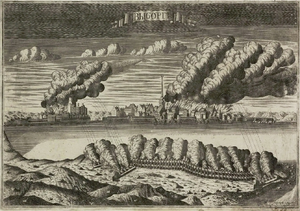
After the failure of 1712, Peter the Great ordered that further campaigns in war-ravaged regions of Finland with poor transportation networks were to be performed along the coastline and the seaways near the coast. Alarmed by the Russian preparations Lybecker requested naval units to be brought in as soon as possible in the spring of 1713. However, like so often, Swedish naval units arrived only after the initial Russian spring campaign had ended.[11] Nominally under the command of Apraksin, but accompanied Peter the Great, a fleet of coastal ships together with 12,000 men – infantry and artillery – began the campaign by sailing from Kronstadt on 2 May 1713; a further 4,000 cavalry were later sent overland to join with the army. The fleet had already arrived at Helsinki on 8 May and were met by 1,800 Swedish infantry under General Carl Gustaf Armfeldt. Together with rowers from the ships the Russians had 20,000 men at their disposal even without the cavalry. The defenders, however, managed to fend off landing attempts by the attackers until the Russians landed at their flank at Sandviken, which forced Armfelt to retire towards Porvoo (Borgå) after setting afire both the town and all the supplies stored there as well as bridges leading north from the town. It was only on 12 May that Swedish squadron under Admiral Erik Johan Lillie made it to Helsinki but there was nothing it could do.[12]
The bulk of the Russian forces moved along the coast towards Borgå and the forces of Lybecker, whom Armfelt had joined. On 21–22 May 1713 a Russian force of 10,000 men landed at Pernå (Pernaja) and constructed fortifications there. Large stores of supplies and munitions were transported from Vyborg and Saint Petersburg to the new base of operations. Russian cavalry managed to link up with the rest of the army there as well. Lybecker's army of 7000 infantry and 3000 cavalry avoided contact with the Russians and instead kept withdrawing further inland without even contesting the control of Borgå region or the important coastal road between Helsinki (Helsingfors) and Turku (Åbo). This also severed the contact between Swedish fleet and ground forces and prevented Swedish naval units from supplying it. Soldiers in the Swedish army who were mostly Finnish resented being repeatedly ordered to withdraw without even seeing the enemy. Lybecker was soon recalled to Stockholm for a hearing and Armfelt was ordered to the command of the army. Under his command the Swedish army in Finland stopped to engage the advancing Russians at Pälkäne in October 1713, where a Russian flanking manoeuvre forced him to withdraw to avoid getting encircled. The armies met again later at Napue in February 1714, where the Russians won a decisive victory.[13]
In 1714 far greater Swedish naval assets were diverted towards Finland, which managed to cut the coastal sea route past Hangö cape already in early May 1714. This caused severe trouble for Russian supply route to Turku and beyond as supplies had to be carried overland. The Russian galley fleet arrived to the area on 29 June but stayed idle until 26–27 July when, under the leadership of Peter, Russian galleys managed to run the blockade making use of calm weather, which immobilized the Swedish battlefleet while losing only one galley of roughly 100. A small, hastily assembled Swedish coastal squadron met the Russian galley fleet west of Hangö cape in the Battle of Gangut and was overpowered by the Russians who had nearly ten-fold superiority. Russian breach of the blockade at Hangö forced the Swedish fleet to withdraw to prevent the Russian fleet from reaching Sweden itself. The Russian army occupied Finland mostly in 1713–1714, capturing Åland from where the population had already fled to Sweden on 13 August 1714. Since the Russian galley fleet was not able to raid the Swedish coast, with the exception of Umeå, which was plundered on 18 September, the fleet instead supported the advance of the Russian army, which led to hastily withdrawal by the Swedish army from Raahe (Brahestad) to Tornio (Torneå). The brutal occupation period of Finland in 1714–1721 is known as the Great Wrath.[14]
1710-1716: السويد وشمال ألمانيا
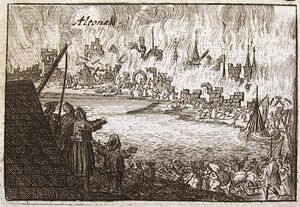
In 1710, the Swedish army in Poland retreated to Swedish Pomerania, pursued by the coalition. In 1711, siege was laid to Stralsund. Yet the town could not be taken due to the arrival of a Swedish relief army, led by general Magnus Stenbock, which secured the Pomeranian pocket before turning west to defeat an allied army in the Battle of Gadebusch. Pursued by coalition forces, Stenbock and his army was trapped and surrendered during the Siege of Tönning.[15]
In 1714, Charles XII returned from the Ottoman Empire, arriving in Stralsund in November. In nearby Greifswald, already lost to Sweden, Russian tsar Peter the Great and British king George I, in his position as Elector of Hanover, had just signed an alliance on 17 (OS)/28 (NS) October.[16] Previously a formally neutral party in the Pomeranian campaigns, Brandenburg-Prussia openly joined the coalition by declaring war on Sweden in the summer of 1715.[17] Charles was then at war with much of Northern Europe, and Stralsund was doomed. Charles remained there until December 1715, escaping only days before Stralsund fell. When Wismar surrendered in 1716, all of Sweden's Baltic and German possessions were lost.[18]
1716-1718: النرويج
After Charles XII had returned from the Ottoman Empire and resumed personal control of the war effort, he initiated two Norwegian Campaigns, starting in February 1716, to force Denmark–Norway into a separate peace treaty. Furthermore, he attempted to bar Great Britain access to the Baltic Sea. In search for allies, Charles XII also negotiated with the British Jacobite party. This resulted in Great Britain declaring war on Sweden in 1717. The Norwegian campaigns were halted and the army withdrawn when Charles XII was shot dead while besieging Norwegian Fredriksten on 30 November 1718 (OS). He was succeeded by his sister, Ulrika Eleonora.[19]
1719-1721: السويد
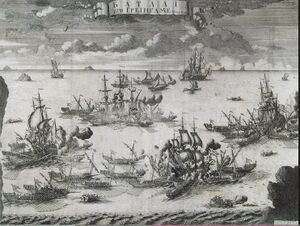
After the death of Charles XII, Sweden still refused to make peace with Russia on Peter's terms. Despite a continued Swedish naval presence and strong patrols to protect the coast, small Russian raids took place in 1716 at Öregrund, while in July 1717 a Russian squadron landed troops at Gotland who raided for supplies. To place pressure on Sweden, Russia sent a large fleet to the Swedish east coast in July 1719. There, under protection of the Russian battlefleet, the Russian galley fleet was split into three groups. One group headed for the coast of Uppland, the second to the vicinity of Stockholm, and the last to coast of Södermanland. Together they carried a landing force of nearly 30,000 men. Raiding continued for a month and devastated amongst others the towns of Norrtälje, Södertälje, Nyköping and Norrköping, and almost all the buildings in the archipelago of Stockholm were burned. A smaller Russian force advanced on the Swedish capital but was stopped at the battle of Stäket on 13 August. Swedish and British fleets, now allied with Sweden, sailed from the west coast of Sweden but failed to catch the raiders.[20]
After the treaty of Frederiksborg in early 1720, Sweden was no longer at war with Denmark, which allowed more forces to be placed against the Russians. This did not prevent Russian galleys from raiding the town of Umeå once again. Later in July 1720 a squadron from the Swedish battlefleet engaged the Russian galley fleet in the battle of Grengam. While the result of the battle is contested, it ended Russian galley raids in 1720. As negotiations for peace did not progress, the Russian galleys were once again sent to raid the Swedish coast in 1721, targeting primarily the Swedish coast between Gävle and Piteå.[21]
أما الحكومة السويدية، التي ندر أن جنحت إلى التطرف، فقد سارعت بمفاوضات الصلح. وبمقتضى معاهدتي استوكهولم (20 نوفمبر 1719 و 1 فبراير 1720) نزلت عن بريمن وفيردين لهانوفر، وعن ستيتين لبروسيا، ورفضت أول الأمر مطالب بطرس بجميع الأراضي السويدية في البلطيق الشرقي، فغزت الجيوش الروسية ثلاث مرات هذه الدولة التي استنزفت الحروب دماءها، وخربت أراضيها الساحلية ومدنها.
السلام
By the time of Charles XII's death, the anti-Swedish allies became increasingly divided on how to fill the power gap left behind by the defeated and retreating Swedish armies. George I and Frederik IV both coveted hegemony in northern Germany, while Augustus the Strong was concerned about the ambitions of Frederick William I on the southeastern Baltic coast. Peter the Great, whose forces were spread all around the Baltic Sea, envisioned hegemony in East Central Europe and sought to establish naval bases as far west as Mecklenburg. In January 1719, George I, Augustus and emperor Charles VI concluded a treaty in Vienna aimed at reducing Russia's frontiers to the pre-war limits.[19]
Hanover-Great Britain and Brandenburg-Prussia thereupon negotiated separate peace treaties with Sweden, the treaties of Stockholm in 1719 and early 1720, which partitioned Sweden's northern German dominions among the parties. The negotiations were mediated by French diplomats, who sought to prevent a complete collapse of Sweden's position on the southern Baltic coast and assured that Sweden was to retain Wismar and northern Swedish Pomerania. Hanover gained Swedish Bremen-Verden, while Brandenburg-Prussia incorporated southern Swedish Pomerania.[22] Britain would briefly switch sides and supported Sweden before leaving the war. In addition to the rivalries in the anti-Swedish coalition, there was an inner-Swedish rivalry between Charles Frederick, Duke of Holstein-Gottorp, and Frederick I of Hesse-Cassel for the Swedish throne. The Gottorp party succumbed and Ulrike Eleonora, wife of Frederick I, transferred power to her husband in May 1720. When peace was concluded with Denmark, the anti-Swedish coalition had already fallen apart, and Denmark was not in a military position to negotiate a return of its former eastern provinces across the sound. Frederick I was, however, willing to cede Swedish support for his rival in Holstein-Gottorp, which came under Danish control with its northern part annexed, and furthermore cede the Swedish privilege of exemption from the Sound Dues. A respective treaty was concluded in Frederiksborg in June 1720.[22]
In addition to the rivalries in the anti-Swedish coalition, there was an inner-Swedish rivalry between Charles Frederick, Duke of Holstein-Gottorp, and Frederick I of Hesse-Cassel for the Swedish throne. The Gottorp party succumbed and Ulrike Eleonora, wife of Frederick I, transferred power to her husband in May 1720. When peace was concluded with Denmark, the anti-Swedish coalition had already fallen apart, and Denmark was not in a military position to negotiate a return of its former eastern provinces across the sound. Frederick I was, however, willing to cede Swedish support for his rival in Holstein-Gottorp, which came under Danish control with its northern part annexed, and furthermore cede the Swedish privilege of exemption from the Sound Dues. A respective treaty was concluded in Frederiksborg in June 1720.[22]
أخيراً، بمقتضى معاهدة نيستاد (30 أغسطس 1721) حصلت روسيا على ليڤونيا، وإستونيا، وإنگريا، وجزء من فنلندا.[23] Sweden's dissatisfaction with the result led to fruitless attempts at recovering the lost territories in the course of the following century, such as the Russo-Swedish War (1741–1743), and the Russo-Swedish War (1788–1790).[22] وهكذا ترك الصراع على البلطيق روسيا ظافرة، وجعل منها دولة عظمى".
أما القيصر المكدود، المكتهل، الظافر رغم ذلك، والذي وصل إلى بطرسبرج ومعه نبأ السلام، وهتاف السلام، السلام "مير! مير!" فقد حياه شعبه أباً لوطنه، وإمبراطور لأقاليم روسيا كلها، ولقبه ببطرس الأكبر.
Saxe-Poland-Lithuania and Sweden did not conclude a formal peace treaty; instead, they renewed the Peace of Oliva that had ended the Second Northern War in 1660.[24]
Sweden had lost almost all of its "overseas" holdings gained in the 17th century and ceased to be a major power. Russia gained its Baltic territories and became one of the greatest powers in Europe.
انظر أيضاً
ملاحظات
- ^ أ ب ت ث كارل الثاني عشر من السويد, Frederick IV of Holstein-Gottorp, Augustus II and Frederick IV of Denmark-Norway were all grandsons of Frederik III of Denmark-Norway
الهامش
- ^ http://www.wfgamers.org.uk/resources/C18/prusorg.htm
- ^ "Den preussiska arméns fälttåg 1702-1715". Tacitus.nu. Retrieved 2010-06-24.
- ^ Ericson, Lars, Svenska knektar (2004) Lund: Historiska media[صفحة مطلوبة]
- ^ Lindegren, Jan, Det danska och svenska resurssystemet i komparation (1995) Umeå : Björkås : Mitthögsk[صفحة مطلوبة]
- ^ أ ب خطأ استشهاد: وسم
<ref>غير صحيح؛ لا نص تم توفيره للمراجع المسماةEB1911 - ^ Richard Brzezinski. Lützen 1632: Climax of the Thirty Years' War. Osprey Publishing, 2001. p. 19
- ^ النصر الروسي في گانگوت (هانكو)، 1714 بريشة موريس باكوا، حـُفرت 1724
- ^ Mattila (1983), p. 27–31.
- ^ Mattila (1983), p. 32–33.
- ^ Mattila (1983), p. 30.
- ^ Mattila (1983), p. 33.
- ^ Mattila (1983), p. 33–35.
- ^ Mattila (1983), p. 35.
- ^ Mattila (1983), p. 38–46.
- ^ Wilson 1998, p. 140
- ^ Torke 2005, p. 165
- ^ Meier 2008, p. 23
- ^ North 2008, p. 53
- ^ أ ب Frost 2000, pp. 295–296
- ^ Mattila (1983), p. 47.
- ^ Mattila (1983), p. 48-51.
- ^ أ ب ت ث Frost 2000, p. 296
- ^ Rambaud, Arthur (1890). Recueil des instructions données aux ambassadeurs et ministres de France depuis les traités de Westphalie jusqu'à la Révolution française. Paris: Ancienne Librairie Germer Baillière et Cie. p. 232.
- ^ Donnert 1997, p. 510
المصادر
- مقالات بالمعرفة بحاجة لذكر رقم الصفحة بالمصدر from September 2010
- Harv and Sfn no-target errors
- Articles with unsourced statements from May 2008
- Articles with hatnote templates targeting a nonexistent page
- Pages using multiple image with auto scaled images
- الحرب الشمالية العظمى
- نزاعات القرن 18
- حروب الدنمارك
- حروب پولندا
- حروب پروسيا
- حروب الدولة العثمانية
- حروب روسيا
- حروب ساكسونيا
- حروب السويد
- حروب النرويج
- تاريخ پولندا (1569–1795)
- العلاقات الپولندية-الروسية
- القتال في العصر الحديث المبكر
- القرن 18 في السويد
- القنر 18 في الدنمارك
